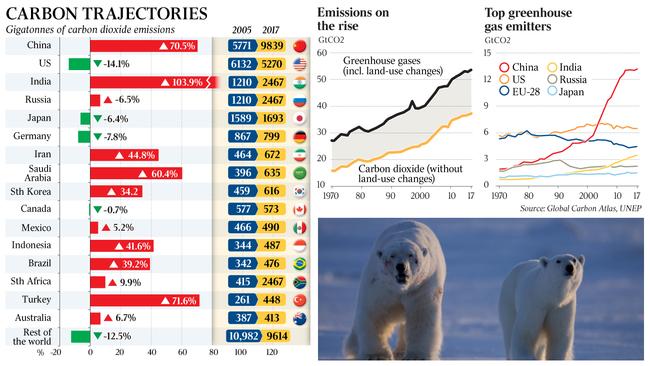Five times more effort needed on carbon action
At least a fivefold increase in efforts is needed to align global climate action and emissions with limiting warming to 1.5C.

Nations must triple their efforts to cut greenhouse gas emissions to meet the Paris Agreement goal of limiting warming to less than 2C, a new UN-backed report warns.
At least a fivefold increase in efforts is needed to align global climate action and emissions with limiting warming to 1.5C by the end of this century.
The report was released to coincide with a UN meeting in New York called by Secretary-General Antonio Guterres to encourage countries to lift their action on climate change.
It was compiled by the World Meteorological Organisation under the auspices of the Science Advisory Group of the UN Climate Action Summit.
It brings together the latest climate science-related updates from the WMO, UN Environment, Intergovernmental Panel on Climate Change, Global Carbon Project, Future Earth, Earth League and the Global Framework for Climate Services.
Another report released on Monday said ocean-based climate action could more than offset carbon dioxide emissions from all of the world’s existing coal-fired power stations.
Half of the savings could come from building offshore wind farms with the remainder from better shipping, restoring ecosystems and putting more seaweed and seafood into global diets.
The report was issued by the high-level panel for a sustainable ocean economy, which included Scott Morrison.

Scaling up ocean-based renewable energy could save up to 5.4 gigatonnes of carbon dioxide annually by 2050, equivalent to taking more than a billion cars off the road each year.
Decarbonising domestic and international shipping and transport could cut up to 1.8 gigatonnes of CO2 annually by 2050.
Increasing the protection and restoration of “blue carbon” ecosystems — mangroves, seagrasses and salt marshes — could prevent about one gigatonne of CO2 from entering the atmosphere by 2050.
Using low-carbon sources of protein from the ocean, such as seafood and seaweeds, to help feed future populations in a healthy and sustainable way, while easing emissions from land-based food production, could support emission reductions of up to 1.24 gigatonnes of CO2 each year by 2050.
The Prime Minister said that the Australian government was committed to ensuring the long-term health of our shared ocean.
“We understand the importance of a healthy ocean to livelihoods, security, and sustainability, and the need to collectively address the threats to our ocean, including climate change,” Mr Morrison said.
“Australia is taking action to underpin the high-level panel’s call to ocean-based climate action.
“We are protecting coastal habitats such as reefs, mangroves, tidal marshes and seagrasses through our leadership on the International Partnership for Blue Carbon, the establishment of a new Indian Ocean Rim Association Blue Carbon Hub, and our historic levels of funding to protect the iconic Great Barrier Reef.”
The United in Science report said that the average global temperature for 2015-2019 was estimated to be 1.1C above pre-industrial times and on track to be “the warmest of any equivalent period on record”.
“Widespread and long-lasting heatwaves, record-breaking fires and other devastating events, such as tropical cyclones, floods and drought, have had major impacts on socio-economic development and the environment,” it said.
The extent of Arctic summer sea-ice had declined at a rate of about 12 per cent per decade from the period starting in 1079 and ending last year.
The sea-level rise was accelerating, and sea water was becoming more acid.



